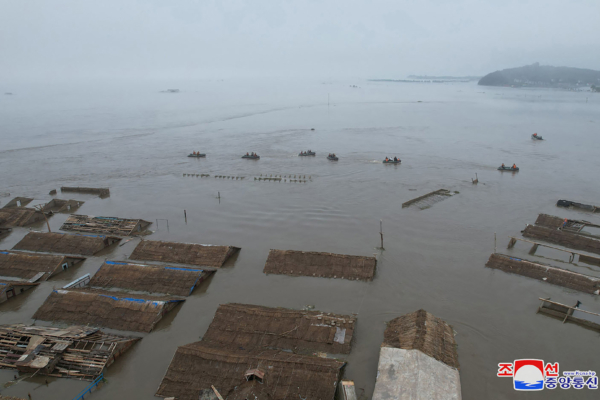In North Korea’s Pyongan Province, elementary and middle school students are being forced to collect five “football-sized” stones every day for the construction of flood levees. The region is currently in the rainy season, and last year experienced severe flooding due to heavy rains, resulting in the deaths or disappearances of thousands of people.
According to Radio Free Asia, multiple sources in Pyongan Province revealed that the embankment construction project for flood prevention is ongoing. Over the past two weeks, students from elementary and middle schools have been mobilized to collect stones every day, including Sundays, without any rest days.
In North Korea, it is a common practice for local governments to issue mobilization orders to compel citizens to contribute labor for public projects.
An insider from the Education Department in Pyongan Province stated, “Each student is required to transport five football-sized stones to the construction site every day.”
Another source from Pyongan Province informed the radio station that students from various areas in Hyesan City gather every afternoon from 2 pm to 6 pm to “pick up football-sized stones” and deliver them to the construction site of the embankment upstream of the river.
The construction period for the embankment is scheduled to continue until the end of June, but due to a shortage of stones, delays are expected. To make up for the shortfall, students from several regions have been instructed to collect stones from old quarries or mining sites.
Sources revealed that these quarrying operations have led to accidents, affecting the health of students and sparking protests from parents.
One source mentioned, “Accidents during quarrying are frequent, with people getting injured in the process, and some students even experiencing nosebleeds from exhaustion while sleeping at night.”
He added that the discontent among parents is growing, with some refusing to allow their children to participate in stone collection work at schools, opting to keep them at home instead.
North Korean official media reported on June 21 that heavy rainfall occurred in Pyongyang as well as several northern and central provinces, prompting the meteorological department to issue warnings in multiple areas. From 5 pm on June 19 to 8 pm on June 20, rainfall in Pyongyang reached 140 millimeters.
In July last year, several areas along the Yalu River near the border between North Korea and China were severely affected by flooding, leading authorities to expedite flood prevention measures before the onset of this year’s rainy season. North Korea’s rainy season typically begins in June and lasts until September.
South Korean media reported that the floods in North Korea last year resulted in over a thousand deaths or missing persons, and authorities may have executed some officials deemed responsible.
The Korean Central News Agency claimed that over 5,000 stranded individuals were rescued, thanks to North Korean leader Kim Jong-Un’s on-site command of flood relief efforts.
A resident from Pyongan Province told Radio Free Asia that in the days following evacuation, residents who escaped the disaster area were compelled to watch propaganda videos portraying Kim Jong-Un as a hero, and they were not allowed to show any signs of sadness on their faces.
The resident recounted how on the day of their rescue, flood victims cried in despair due to their elderly parents and young children being swept away by the floodwaters, but they were stopped by police guards. The guards demanded that the victims “thank Kim Jong-Un for his love for the people.”
The resident added that the victims are under constant surveillance. “They cannot cry out… resentment continues to grow within them.”

